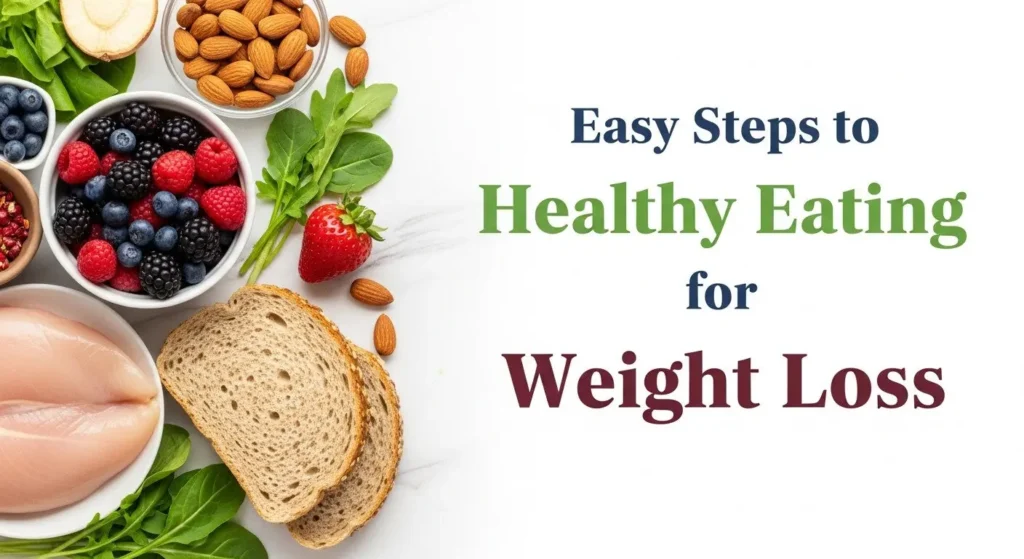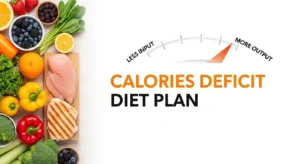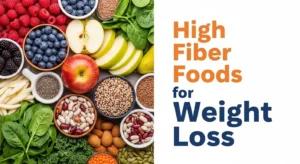Losing weight can feel like a big challenge, especially when you're not sure where to start with your food choices. You might hear about strict diets, cutting out entire food groups, or eating only tiny portions.

But what if we told you that healthy eating for weight loss doesn't have to be about starving yourself or giving up all your favorite foods? It's actually about making smart, simple changes that add up over time and help you feel better, have more energy, and reach your goals.
This guide is here to show you that healthy eating for weight lose can be easy, enjoyable, and something you can stick with for the long run.
Healthy Food Swap Tool 🍎➡️🥦
Swap common unhealthy foods for healthier options and see how they benefit your weight loss journey!
Select a food from the list above to see a healthier swap and its benefits!
Key Takeaways
- Focus on Whole Foods: Fill your plate with fruits, vegetables, lean proteins, and whole grains. These foods are packed with nutrients and keep you full.
- Watch Your Portions: Learn how much food is just right for you, not too little and not too much, using simple tricks like the plate method.
- Stay Hydrated: Drinking plenty of water is super important for your body and can help you feel less hungry.
- Plan Ahead: Thinking about your meals and snacks before you eat helps you make healthier choices and avoid last-minute unhealthy options.
- Be Patient and Kind to Yourself: Healthy eating for weight loss is a journey, not a race. Celebrate small wins and don't get discouraged by setbacks.
Understanding the Basics of Healthy Eating For Weight Loss
Before we dive into specific foods, let's understand how healthy eating for weight loss works. It's actually quite simple: to lose weight, you need to eat fewer calories than your body uses. This is called creating a “calorie deficit.” Think of calories as the energy your body needs to do everything, from breathing to running. If you give your body less energy than it needs, it will start using stored energy (which is fat) to make up the difference.
But it's not just about calories! The type of calories you eat matters a lot. A candy bar might have the same number of calories as an apple, but the apple is packed with vitamins, fiber, and water, making it much better for your body and helping you feel full longer. This is why we focus on “nutrient density” – getting the most goodness out of your food.
Many “fad diets” promise quick fixes by cutting out whole food groups or making you eat very little. While you might lose weight fast, these diets are often hard to stick to, unhealthy, and the weight usually comes right back. Our goal is to help you build healthy habits that you can keep up forever, not just for a few weeks.
The Power of Whole Foods
The secret to healthy eating for weight loss lies in choosing whole, unprocessed foods. What are whole foods? They are foods that are as close to their natural state as possible, with little to no added sugars, unhealthy fats, or artificial ingredients.
Let's look at the main groups:
1. Fruits and Vegetables
- Why they're great: They are low in calories but high in fiber, vitamins, and minerals. Fiber helps you feel full, which means you're less likely to overeat.
- How to eat more:
- Add spinach or kale to your morning smoothie.
- Snack on apples with a little peanut butter, or carrots with hummus.
- Fill half your plate with colorful veggies at every meal.
- Try new fruits and veggies each week!
2. Lean Proteins
- Why they're great: Protein is super important for building and repairing muscles, and it keeps you feeling full and satisfied for hours. This helps prevent snacking between meals.
- Good choices: Chicken breast (skinless), turkey, fish (like salmon or cod), eggs, beans, lentils, tofu, Greek yogurt.
- Easy tips:
- Include a source of lean protein with every meal.
- Grill, bake, or steam your protein instead of frying.
- Try a meatless meal once or twice a week using beans or lentils.
3. Whole Grains
- Why they're great: Unlike refined grains (like white bread or white rice) that have had their good parts removed, whole grains contain fiber, vitamins, and minerals. They give you steady energy and help with digestion.
- Smart swaps:
- Instead of white bread: Whole-wheat bread
- Instead of white rice: Brown rice, quinoa, farro
- Instead of sugary cereal: Oatmeal
- Remember: Even whole grains have calories, so watch your portion sizes!
4. Healthy Fats
- Why they're great: Don't be afraid of fats! Healthy fats are essential for your body and can help you feel full and satisfied. They also help your body absorb vitamins.
- Best sources: Avocados, nuts (almonds, walnuts), seeds (chia, flax, sunflower), olive oil, fatty fish (salmon).
- A little goes a long way: Fats are calorie-dense, so use them in small amounts. A quarter of an avocado, a small handful of nuts, or a tablespoon of olive oil is usually enough.
Portion Control & Mindful Eating
Healthy eating for weight loss is a great start, but how much you eat also plays a huge role. Even nutritious foods can lead to weight gain if consumed in excess, which is why portion control is so important.
Simple Ways to Control Your Portions:
- The Plate Method: Imagine your plate divided:
- Half your plate: Non-starchy vegetables (broccoli, spinach, carrots)
- One-quarter of your plate: Lean protein (chicken, fish, beans)
- One-quarter of your plate: Whole grains or starchy vegetables (brown rice, sweet potato)
- Use Smaller Plates: A smaller plate makes your meal look bigger, tricking your brain into feeling more satisfied with less food.
- Measure and Learn: For a week or two, try measuring your food with measuring cups or a food scale. This helps you learn what a proper portion actually looks like. You don't have to do it forever, but it's a great learning tool.
- Read Food Labels: Pay attention to the “serving size” on food packages. It's often much smaller than you think!
Mindful Eating: Slow Down and Listen to Your Body
Mindful eating is about paying attention to your food and how your body feels. It helps you recognize when you're truly hungry and when you're full.
- Eat Slowly: Put your fork down between bites. Chew your food thoroughly.
- Avoid Distractions: Turn off the TV, put away your phone. Focus on the taste, smell, and texture of your food.
- Listen to Your Body: Are you truly hungry, or are you eating out of boredom, stress, or habit? Stop eating when you feel satisfied, not stuffed. It takes about 20 minutes for your brain to get the “I'm full” signal from your stomach.
- Savor Your Food: Enjoy every bite! When you truly taste and appreciate your food, you're more likely to feel satisfied.
Hydration: Your Secret Weapon
Water is often overlooked in healthy eating for weight loss, but it’s incredibly important! Our bodies are mostly water, and it plays a role in nearly every bodily function, including metabolism and how your body burns calories.
How Water Helps with Healthy Eating for Weight Loss:
- Boosts Metabolism: Water helps your body burn calories more efficiently.
- Reduces Hunger: Sometimes, your body confuses thirst with hunger. Drinking water before meals can help you eat less.
- Prevents Bloating: When you're dehydrated, your body might hold onto water, causing bloating. Drinking enough water helps your body release excess fluid.
- Replaces Sugary Drinks: Swapping sugary sodas, juices, and sweetened teas for water can save you hundreds of calories a day!
Tips for Drinking More Water:
- Keep a reusable water bottle with you all day.
- Drink a glass of water before each meal.
- Add flavor to your water with slices of lemon, lime, cucumber, or berries.
- Set reminders on your phone to drink water throughout the day.
Meal Planning & Preparation
One of the biggest hurdles to healthy eating is not having healthy options ready when hunger strikes. This is where meal planning and preparation become your best friends!
Why Plan Ahead?
- Saves Time & Money: Less last-minute scrambling and eating out.
- Reduces Stress: You know what you're eating, so no more “what's for dinner?” panic.
- Helps You Stay on Track: When healthy food is ready, you're less likely to grab unhealthy fast food or snacks.
Simple Steps to Meal Prep:
- Pick a Day: Choose one day a week (like Sunday) to plan and prep your meals.
- Plan Your Meals: Decide what you'll eat for breakfast, lunch, and dinner for the week. Look for recipes that use similar ingredients to save time.
- Breakfast Ideas: Overnight oats, scrambled eggs with veggies, Greek yogurt with fruit.
- Lunch Ideas: Large salads with lean protein, leftover healthy dinners, whole-grain wraps.
- Dinner Ideas: Baked chicken and roasted veggies, lentil soup, fish with quinoa.
- Make a Grocery List: Write down all the ingredients you need. Stick to your list at the store to avoid impulse buys.
- Prep Your Food:
- Wash and chop vegetables.
- Cook a batch of grains (brown rice, quinoa).
- Cook a large batch of lean protein (baked chicken breast, hard-boiled eggs).
- Portion out snacks into small containers.
Example Weekly Meal Prep:
| Meal | Idea 1 (Cook Once, Eat Twice) | Idea 2 (Quick Assembly) |
|---|---|---|
| Breakfast | Overnight Oats with Berries (make 3-4 servings) | Greek Yogurt with a handful of nuts and a piece of fruit |
| Lunch | Large Salad with Grilled Chicken (cook chicken for 3 days) | Whole-Wheat Wrap with hummus, veggies, and turkey slices |
| Dinner | Baked Salmon with Roasted Broccoli and Quinoa (cook extra) | Lentil Soup (make a big batch for 2-3 dinners) |
| Snacks | Apple slices & peanut butter, hard-boiled eggs, small handful of almonds | Veggie sticks & hummus, rice cakes with avocado |
Smart Snacking
Snacks can be a good part of a weight loss plan, but only if they're the right kind! Healthy snacks can keep your energy up between meals and prevent you from getting too hungry, which often leads to overeating at your next meal.
When to Snack:
- When you feel a true hunger pang between meals.
- If there's a long gap between meals (e.g., more than 4-5 hours).
- Not when you're bored, stressed, or just want something to munch on.
Healthy Snack Ideas (Aim for Protein + Fiber!):
- Apple slices with a tablespoon of peanut butter: Fiber from apple, protein/healthy fat from peanut butter.
- Greek yogurt with a few berries: High in protein, berries add fiber and sweetness.
- A handful of almonds or walnuts: Healthy fats, protein, and fiber. Just a small handful!
- Carrot sticks or bell pepper slices with hummus: Crunchy veggies, creamy dip with protein and fiber.
- Hard-boiled egg: Pure protein, very filling.
- Cottage cheese with tomato slices: Protein-rich and savory.
- Rice cakes with avocado and a sprinkle of “Everything Bagel” seasoning: Light, crunchy, and satisfying.
Dealing with Cravings & Emotional Eating
Cravings are normal! It’s also common to eat when you’re not physically hungry, but because you’re stressed, sad, bored, or happy. This is called emotional eating. Learning to manage these moments is a key step toward healthy eating for weight loss.
How to Handle Cravings:
- Identify the Trigger: Are you craving chocolate because you're truly hungry, or because you just had a stressful call? Knowing why you're craving something can help you choose how to respond.
- Wait 10 Minutes: Often, cravings pass. Distract yourself for 10 minutes – take a walk, drink a glass of water, call a friend. See if the craving is still there.
- Find a Healthy Swap: Sometimes, you can find a healthier alternative that satisfies a similar craving.
- Craving something sweet? Try fruit, a small piece of dark chocolate, or a fruit smoothie.
- Craving something crunchy? Try air-popped popcorn, veggie sticks, or roasted chickpeas.
- Allow Small Treats (in moderation): Don't forbid yourself from eating your favorite foods entirely. This can lead to feeling deprived and then overeating later. Instead, enjoy a small portion of your favorite treat occasionally. For example, a small scoop of ice cream instead of the whole tub.
Dealing with Emotional Eating:
- Recognize Your Emotions: Before you reach for food, ask yourself: “What am I really feeling right now?”
- Find Other Coping Mechanisms:
- If you're stressed: Try deep breathing, meditation, going for a walk, listening to music.
- If you're bored: Find a hobby, read a book, call a friend, clean something.
- If you're sad or lonely: Talk to someone you trust, watch a funny movie, do something you enjoy.
- Keep a Journal: Writing down when and what you eat, and how you're feeling, can help you spot patterns in your emotional eating.
“Your relationship with food is a journey. Be patient, be kind, and celebrate every step forward toward healthy eating for weight loss.”
The Role of Protein and Fiber
We’ve mentioned protein and fiber a few times because they are superstars in healthy eating for weight loss!
- Protein: It's the most filling nutrient. When you eat enough protein, you feel full for longer, which reduces your overall calorie intake. It also helps preserve your muscles while you lose fat.
- Good sources: Lean meats, poultry, fish, eggs, dairy products (Greek yogurt, cottage cheese), beans, lentils, tofu, nuts, seeds.
- Fiber: Found mostly in plant foods, fiber adds bulk to your meals without adding many calories. It slows down digestion, helping you feel full and keeping your blood sugar steady. It also helps keep your digestive system healthy.
- Good sources: Fruits, vegetables, whole grains, beans, lentils, nuts, seeds.
Aim to include a good source of protein and fiber in every meal and snack. This powerful duo will keep you satisfied and energized!
Building Sustainable Habits
The goal isn’t just to lose weight, but to keep it off and live a healthier life. This involves building habits that support healthy eating for weight loss and can be maintained long-term.
Tips for Lasting Change:
- Start Small: Don't try to change everything at once. Pick one or two easy steps from this guide and focus on them for a week or two. Once those feel natural, add another.
- Example: This week, I'll drink water instead of soda. Next week, I'll add a veggie to every dinner.
- Be Consistent, Not Perfect: You're going to have days where you don't eat perfectly. That's okay! Don't let one less-than-perfect meal or day derail your whole effort. Just get back on track with your next meal.
- Celebrate Progress: Acknowledge your successes, no matter how small. Did you choose an apple over chips? High five! Did you drink all your water today? Awesome! Celebrating keeps you motivated.
- Find Your “Why”: Why do you want to eat healthier and lose weight? Is it for more energy, better health, to play with your kids, or feel more confident? Remembering your “why” can keep you going when things get tough.
- Get Support: Share your goals with a friend or family member, or join a supportive community. Having people cheer you on can make a big difference.
Conclusion
Healthy eating for weight loss isn't about complicated rules or crash diets. It's about making smart, simple choices that nourish your body, keep you feeling full, and fit into your everyday life. By focusing on whole foods, controlling your portions, staying hydrated, planning ahead, and listening to your body, you're building a strong foundation for lasting health and weight loss.
Remember, this is a journey of learning and growing. There will be good days and challenging days, but every healthy choice you make is a step forward. Be patient with yourself, celebrate your efforts, and enjoy the process of becoming a healthier, happier you! You've got this








